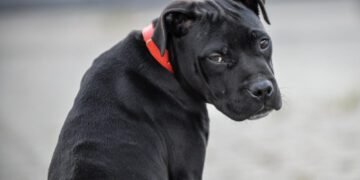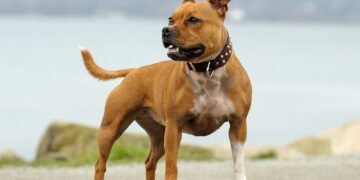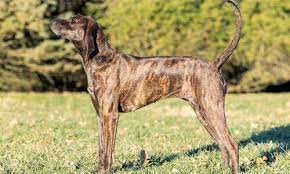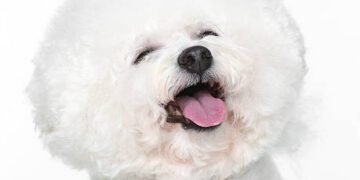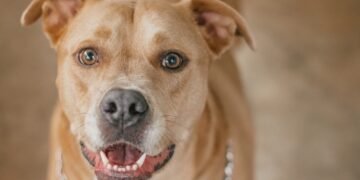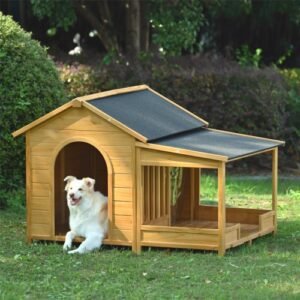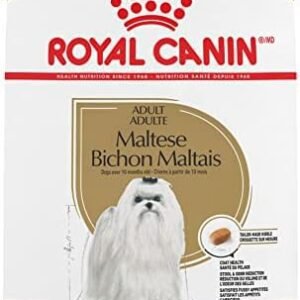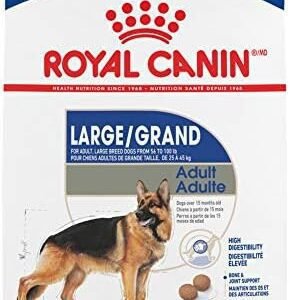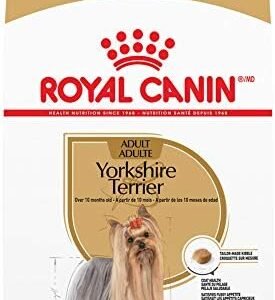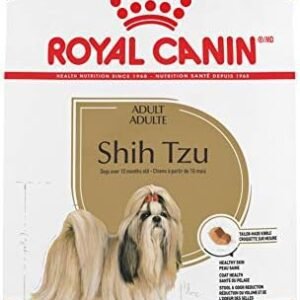The Bullboxer Pit is a captivating and intriguing dog breed that has been gaining popularity among dog enthusiasts in recent years. This unique crossbreed combines the strength and tenacity of the American Pit Bull Terrier with the intelligence and loyalty of the Boxer. If you’re considering bringing a Bullboxer Pit into your life or simply want to learn more about this fascinating breed, you’ve come to the right place. In this comprehensive guide, we will delve into every aspect of the Bullboxer Pit’s characteristics, care requirements, and much more.
Bullboxer Pit Breed Overview
To better understand the Bullboxer Pit breed, let’s start by examining some key characteristics and statistics.
| Field | data |
|---|---|
| Height | 20 and 27 inches at the shoulder |
| Weight | 50 and 80 pounds |
| Life Span | 10 and 14 years |
| Good with | Children, other dogs, and other pets if socialized well |
| Temperament | Loyal, energetic, protective, playful, affectionate, and sometimes stubborn |
| Intelligence | High; they are eager to learn and please their owners |
| Shedding Amount | Moderate; they shed year-round and need regular brushing |
| Grooming | Easy; they have short and smooth coats that only need occasional bathing and trimming |
| Exercise Needs | High; they need at least an hour of vigorous exercise every day to keep them healthy and happy |
| Energy Level | High; they are very active and lively dogs that love to play and run |
| Barking Level | Low to moderate; they are not very vocal dogs, but they may bark to alert their owners or express their emotions |
| Drool Amount | Low to moderate; they may drool a bit, especially after drinking water or exercising |
| Coat Length/Texture | Short and smooth; their coats are easy to maintain and feel soft to the touch |
| Colors | Various; their coats can come in almost any color imaginable, but the most common ones are brown, tan, yellow, and black |
| Patterns | Various; their coats can have different markings and patterns, such as brindle, spots, patches, or solid |
It’s important to note that specific information regarding the Bullboxer Pit breed can vary depending on individual dogs and their genetic makeup. However, as we continue with this guide, we will provide you with a comprehensive understanding of the Bullboxer Pit’s general traits and characteristics, even if some specific data is not readily available.
Table of Contents
The Bullboxer Pit’s Unique Origins
The Bullboxer Pit is a crossbreed that originated from two highly regarded and well-loved dog breeds: the American Pit Bull Terrier and the Boxer. This combination results in a dog with a striking appearance and a delightful personality. Understanding the heritage of the Bullboxer Pit is essential for appreciating its unique qualities.
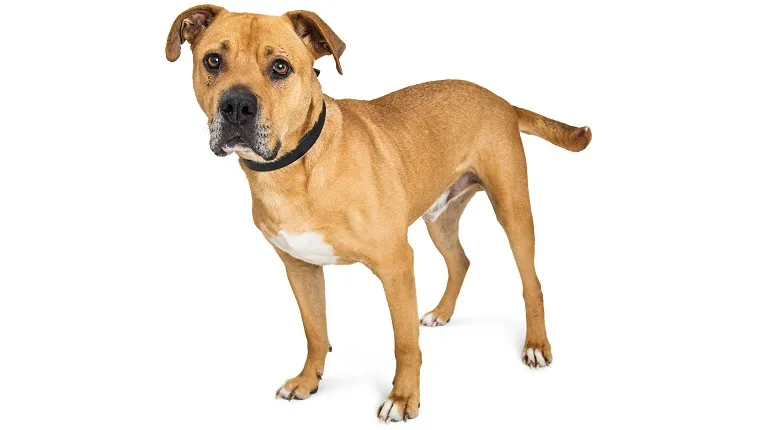
Temperament and Personality
While we may not have specific data available in our table, we can provide valuable insights into the Bullboxer Pit’s temperament and personality. This breed is known for its intelligence, loyalty, and strong protective instincts. They are often affectionate with their families, making them excellent companions and guardians. However, early socialization and consistent training are essential to ensure a well-rounded and well-behaved Bullboxer Pit.
Care and Grooming
Proper care and grooming are vital for the health and well-being of any dog breed, including the Bullboxer Pit. Although specific grooming requirements may vary depending on the individual dog’s coat, regular brushing, nail trimming, and ear cleaning are typically recommended. Additionally, providing your Bullboxer Pit with regular exercise and mental stimulation is crucial to keep them happy and healthy.
Exercise Needs and Energy Level
The Bullboxer Pit is an energetic breed that requires regular exercise to thrive. Daily walks, playtime, and mental stimulation activities are essential to prevent boredom and ensure they get the physical activity they need. Keep in mind that the energy level of a Bullboxer Pit can vary, so
2. Breed History and Origin
The Bullboxer Pit, with its striking appearance and impressive personality, has a history that is as unique and intriguing as the breed itself. In this section, we will delve into the historical development of the Bullboxer Pit, shedding light on the breeds that contributed to its formation, highlighting its distinctive traits, and exploring the relevance of its origin in shaping the breed we know today.
Exploring Their Roots
To understand the Bullboxer Pit’s history, we must go back to its roots. This breed is a result of careful crossbreeding between two remarkable dogs: the American Pit Bull Terrier and the Boxer. Let’s take a closer look at the influence of these parent breeds on the Bullboxer Pit’s development:
The American Pit Bull Terrier
The American Pit Bull Terrier, often referred to as the “Pit Bull,” has a history deeply rooted in bull-baiting and later, dog fighting. These dogs were initially bred for their tenacity, strength, and courage. However, as attitudes towards animal cruelty changed, the Pit Bull’s role shifted to that of a loyal family companion.
The Boxer
On the other side of the genetic equation, we have the Boxer, a breed known for its playful and protective nature. Boxers have a history in Europe, where they were originally bred as hunting dogs and later gained recognition for their abilities as guard dogs and family pets.
The combination of the American Pit Bull Terrier’s resilience and the Boxer’s affable nature paved the way for the creation of the Bullboxer Pit. Breeders aimed to create a dog that possessed the best qualities of both parent breeds, resulting in a loving yet vigilant companion with a distinctive appearance.
Notable Traits
What sets the Bullboxer Pit apart in history are its remarkable traits and features:
Muscular Build
The Bullboxer Pit inherited the strong and muscular physique of the American Pit Bull Terrier. Their robust bodies make them well-suited for various physical activities and tasks, reflecting their ancestors’ strength and endurance.
Loyalty and Protective Instincts
One of the most notable traits of the Bullboxer Pit is its unwavering loyalty to its family. This devotion, combined with their protective instincts, makes them excellent guard dogs and loving companions. These qualities have been present throughout their history, making them a trusted presence in many households.
Adaptability
Bullboxer Pits are known for their adaptability, a trait that traces back to their Boxer ancestry. They can thrive in various living environments, from spacious homes with yards to smaller apartments, as long as they receive adequate exercise and mental stimulation.
Playfulness
The playful nature of the Boxer is another trait that has made its way into the Bullboxer Pit’s genetic makeup. They are known for their exuberance and love of play, which adds a joyful aspect to their personality.
Relevance of Origin
Understanding the origin of the Bullboxer Pit is not merely a historical exercise; it also offers valuable insights into the breed’s characteristics and behavior today:
Temperament
The Bullboxer Pit’s temperament is deeply influenced by the history of its parent breeds. Their protective instincts and loyalty stem from the Pit Bull heritage, while their playfulness and adaptability reflect their Boxer lineage. This unique blend of traits makes them well-rounded companions for families and individuals alike.
Physical Attributes
The Bullboxer Pit’s physical attributes, such as their muscular build, can be traced back to their Pit Bull ancestry. These features have practical implications for their exercise needs and suitability for various activities, making them a versatile breed with a rich history.
Role as Family Dogs
While both the American Pit Bull Terrier and the Boxer have histories that include roles as working and guardian dogs, they have also been cherished as family pets. The Bullboxer Pit continues this tradition by excelling as a loyal and loving family member, combining the best qualities of its predecessors.
In conclusion, the Bullboxer Pit’s history and origin are fascinating aspects of this remarkable breed. Their development from the American Pit Bull Terrier and the Boxer has resulted in a dog with a unique blend of traits and characteristics. Understanding their roots provides valuable insights into their temperament, physical attributes, and role as beloved family dogs. In the next sections, we will explore topics such as training, care, and health considerations for Bullboxer Pits, equipping you with the knowledge to provide the best possible care for your canine companion.
3. Understanding the Bullboxer Pit Breed’s Traits
To truly appreciate the Bullboxer Pit breed and consider them as potential companions, it’s essential to delve into their distinct traits and characteristics. In this section, we will explore their physical attributes, temperament, compatibility with family life, and the environmental needs that contribute to their well-being.
Physical Characteristics
Size
The Bullboxer Pit is a medium to large-sized breed. On average, they stand between 20 to 26 inches (50 to 66 cm) tall at the shoulder and weigh between 50 to 80 pounds (23 to 36 kg). However, individual Bullboxer Pits may vary in size, with some leaning towards the smaller end of this range and others closer to the larger side.
Coat Type
Their coat is short and dense, a feature they inherit from their American Pit Bull Terrier ancestry. This coat type is relatively low-maintenance, requiring regular brushing to keep it healthy and remove loose hair.
Color and Distinguishing Features
Bullboxer Pits come in a variety of colors, including brindle, fawn, black, and white. Their coat may also have white markings. One distinguishing feature often seen in Bullboxer Pits is their broad, muscular chest, a testament to their strength and power.
Temperament Overview

Loyal Companions
Bullboxer Pits are known for their unwavering loyalty and devotion to their families. They form strong bonds with their human counterparts and often become protective of them. This loyalty makes them excellent family companions, as they are likely to go to great lengths to ensure their loved ones are safe and happy.
Playful and Energetic
These dogs have an innate playfulness that adds joy to their presence. They are full of energy and enthusiasm, making them wonderful playmates for active individuals or families. Their playful nature often extends to other dogs and pets in the household.
Safe with Children
When properly trained and socialized from a young age, Bullboxer Pits can be excellent with children. They are known for their patience and affection toward kids, making them suitable for family environments. However, it’s crucial to supervise interactions between any dog and young children to ensure everyone’s safety.
Compatibility with Other Pets
Bullboxer Pits generally get along well with other pets, including dogs and cats, especially when raised together or introduced gradually. Early socialization plays a crucial role in fostering positive relationships with other animals.
Environmental Needs
Space Requirements
While Bullboxer Pits can adapt to various living environments, they thrive in homes with adequate space for them to move and play. A yard or access to open areas for exercise is ideal, but they can also adapt to apartment living if provided with regular exercise.
Temperature Considerations
Their short coat makes them sensitive to extreme temperatures. In hot weather, they can be prone to overheating, so it’s essential to provide shade and access to fresh water. In cold weather, they may need a coat or sweater to stay warm during outdoor activities.
Social Interaction
Bullboxer Pits are social animals and thrive on human interaction
4. Health Considerations and Care
Ensuring the health and well-being of your Bullboxer Pit is of utmost importance to provide them with a happy and fulfilling life. In this section, we will discuss common health issues that this breed may be prone to, their average lifespan, dietary needs, exercise requirements, and grooming practices that contribute to their overall care.
Common Health Issues
While Bullboxer Pits are generally healthy dogs, like all breeds, they can be prone to specific health issues. Being aware of these potential problems and addressing them promptly is crucial for your dog’s well-being. Common health issues in Bullboxer Pits include:
1. Hip Dysplasia
Hip dysplasia is a hereditary condition where the hip joint doesn’t develop correctly, leading to arthritis and pain. Regular veterinary check-ups and maintaining a healthy weight can help manage this issue.
2. Heart Conditions
Bullboxer Pits may be susceptible to certain heart conditions, such as aortic stenosis and dilated cardiomyopathy. Regular cardiac screenings can help detect and manage these conditions early.
3. Skin Allergies
Some Bullboxer Pits may develop skin allergies, which can lead to itching and discomfort. Proper nutrition and regular grooming can help prevent and manage skin issues.
4. Bloat
Bloat, or gastric torsion, is a life-threatening condition where the stomach fills with gas and twists. Feeding smaller, more frequent meals and avoiding strenuous activity after eating can reduce the risk.
5. Obesity
Obesity is a concern for many dogs, including Bullboxer Pits. Maintaining a balanced diet and ensuring they get enough exercise is essential to prevent obesity-related health issues.
6. Cancer
Like many larger breeds, Bullboxer Pits may be more susceptible to certain types of cancer. Early detection through regular check-ups is crucial for timely treatment.
Lifespan and Longevity
The average lifespan of a Bullboxer Pit is typically between 10 to 14 years, though some can live even longer with proper care. To promote a longer and healthier life for your Bullboxer Pit, consider the following tips:
Regular Veterinary Check-Ups
Schedule regular check-ups with your veterinarian to monitor your dog’s overall health and address any potential issues early.
Healthy Diet
Feed your Bullboxer Pit a balanced and nutritious diet to maintain a healthy weight and prevent obesity-related health problems.
Exercise and Mental Stimulation
Provide regular exercise and mental stimulation to keep your dog physically fit and mentally engaged. Daily walks, playtime, and puzzle toys can help.
Preventive Measures
Keep up with vaccinations, flea and tick prevention, and heartworm medication to protect your Bullboxer Pit from preventable diseases.
Diet and Nutrition
Proper nutrition is vital for the well-being of your Bullboxer Pit. Here are some guidelines for their dietary needs:
High-Quality Dog Food
Choose a high-quality dog food that is appropriate for your Bullboxer Pit’s age, size, and activity level. Look for options with real meat as the primary ingredient.
Portion Control
Monitor your dog’s food intake and avoid overfeeding. Follow the feeding guidelines provided on the dog food packaging, and adjust as needed based on your dog’s activity level and weight.
Feeding Schedule
Establish a regular feeding schedule to help with digestion and prevent obesity. Most adult Bullboxer Pits do well with two
5. Choosing and Adopting a Bullboxer Pit Dog Breed
Choosing to adopt a Bullboxer Pit is a significant decision that comes with both responsibilities and rewards. In this section, we will explore the reasons for adoption, the research and preparation required, the adoption process, and ethical considerations when it comes to breeding.
Reasons for Adoption
1. Saving Lives
Adopting a Bullboxer Pit or any rescue dog provides them with a second chance at a loving home. Many dogs in shelters and rescue organizations are in need of a safe and caring environment, and your decision to adopt can be life-saving.
2. Breed-Specific Rescue
By adopting frombreed-specific rescue organizations, you can provide a home for a Bullboxer Pit that may have specific needs and characteristics that match your lifestyle and preferences.
3. Supporting Rescues
Adoption fees often contribute to the operation of rescue organizations, allowing them to continue their vital work in saving dogs and finding them loving homes.
4. Reducing Overpopulation
By adopting, you are helping reduce the demand for commercial breeding, which can contribute to petoverpopulation and the mistreatment of animals in puppy mills.
Research and Preparation
1. Understand Breed-Specific Needs
Before adopting a Bullboxer Pit, it’s crucial to research and understand the breed’s specific needs and characteristics. Consider factors such as their exercise requirements, grooming needs, and temperament to ensure they align with your lifestyle.
2. Financial Responsibility
Owning a dog comes with financial responsibilities, including food, grooming, veterinary care, and potential emergencies. Ensure that you have the financial stability to provide for your Bullboxer Pit’s needs.
3. Home and Living Arrangements
Evaluate your living arrangements to determine if they are suitable for a Bullboxer Pit. Consider factors such as available space, yard size, and any restrictions or regulations related to pet ownership in your area.
4. Time Commitment
Dogs, including Bullboxer Pits, require time and attention. Be prepared to invest time in training, exercise, and companionship to ensure your dog’s well-being.
Adoption Process
1. Research Rescues and Organizations
Startby researching reputable Bullboxer Pit rescue organizations in your area or nearby. Look for organizations that prioritize the health and well-being of their dogs.
2. Application
Once you’ve identified a rescue or organization, fill out their adoption application. Be honest and provide detailed information about your living situation, experience with dogs, and reasons for adopting.
3. Home Visit
Many rescues conduct home visits as part of the adoption process. This involves a representative visiting your home to ensure it is a safe and suitable environment for a Bullboxer Pit.
4. Meet the Dog
After your application is approved, you will have the opportunity to meet potential Bullboxer Pit candidates. Spend time interacting with them to gauge their temperament and compatibility with your family.
5. Adoption Fees
Expect to pay an adoption fee, which typically covers vaccinations, spaying/neutering, and other medical expenses. The fee helps support the rescue organization’s ongoing efforts.
6. Transition Period
Be prepared for an adjustment period when your Bullboxer Pit comes home. Provide patience, love, and consistency as they settle into their new environment.
Breeding and Ethical Considerations
1. Responsible Breeding
If you decide to go through a breeder rather than adoption, it’s crucial to choose a responsible breeder who prioritizes the health and well-being of their dogs. Research breeders thoroughly and ask about their breeding practices.
2. Health Screening
Ethical breeders conduct health screenings for genetic conditions that may affect the breed. Ensure that the breeder provides documentation of health clearances for both the sire and dam of the litter.
3. Genetic Diversity
Responsible breeders prioritize genetic diversity to reduce the risk of inherited health issues. Inbreeding can lead to genetic problems, so choose breeders who consider genetic diversity in their breeding programs.
4. Avoid Puppy Mills
Avoid purchasing puppies from puppy mills or commercial breeding facilities, as these places often prioritize profit over the welfare of the dogs. Always visit the breeder’s facility and meet the parents of the puppy before making a decision.
5. Spaying and Neutering
If you are not planning to breed your Bullboxer Pit, consider spaying or neutering to help control the pet population and reduce the risk of certain health issues.
In conclusion, choosing to adopt a Bullboxer
6. Popularity and Recognition
The popularity and recognition of the Bullboxer Pit breed play significant roles in understanding its current status in the world of dogs. In this section, we will explore the breed’s current popularity, its recognition by kennel clubs and breed organizations, and notable breed varieties or subtypes.
Current Popularity
A Growing Trend
In recent years, the Bullboxer Pit breed has been steadily gaining popularity among dog enthusiasts and families looking for a loyal and affectionate companion. This increasing trend can be attributed to several factors:
1. Versatile Temperament
Bullboxer Pits are known for their adaptable and friendly nature. They are equally at home in active families, singles, or seniors, making them a versatile choice for various lifestyles.
2. Strong Family Bonds
Their deep loyalty and affection for their families have earned them a reputation as excellent family dogs. Many people seek out Bullboxer Pits for their strong bonds and protective instincts.
3. Unique Appearance
The Bullboxer Pit’s distinctive appearance, characterized by its muscular build and expressive face, often attracts attention and admiration from dog lovers.
4. Rescue and Adoption
The increasing emphasis on rescue and adoption has led more people to discover and appreciate the Bullboxer Pit breed through rescue organizations. This has helped boost their popularity and provided a second chance for many dogs.
5. Social Media Influence
Social media platforms have played a role in spreading awareness about the Bullboxer Pit breed. Owners frequently share photos and stories about their beloved pets, showcasing their unique qualities to a wider audience.
Breed Recognition
Kennel Club Recognition
As of my last knowledge update in September 2021, the Bullboxer Pit is not officially recognized as a distinct breed by major kennel clubs like the American Kennel Club (AKC) or the United Kennel Club (UKC). However, it’s worth noting that mixed-breed dogs like the Bullboxer Pit can still participate in events and activities organized by kennel clubs, such as obedience trials or agility competitions.
Breed Organizations
While not recognized by kennel clubs, the Bullboxer Pit has gained recognition from various breed-specific organizations and enthusiasts who appreciate their unique qualities. These organizations often focus on promoting responsible ownership, health, and well-being of Bullboxer Pits.
Notable Breed Varieties
Bullboxer Pit Varieties
The Bullboxer Pit is a crossbreed, resulting from the combination of the American
7. Exercise and Activity Recommendations
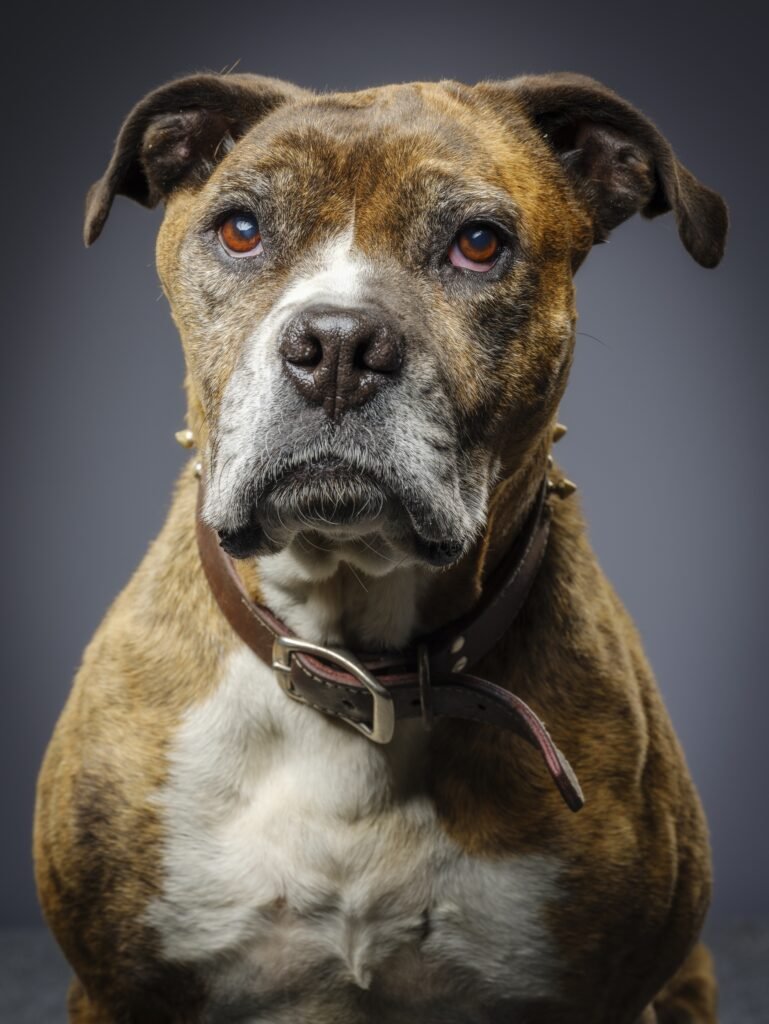
Providing your Bullboxer Pit with adequate exercise and physical activity is essential for their physical and mental well-being. This section will outline a comprehensive exercise plan tailored to the needs of the Bullboxer Pit breed, taking into account their energy level, size, and specific exercise preferences.
Exercise Plan
1. Daily Walks
Bullboxer Pits are an active breed that requires daily exercise to stay healthy and happy. A brisk walk is an excellent way to start the day and helps burn off excess energy. Aim for at least 30 to 60 minutes of walking per day.
2. Playtime
Engage in interactive play sessions with your Bullboxer Pit to provide mental stimulation and exercise. Games like fetch, tug-of-war, and hide-and-seek are great options. Be sure to incorporate toys that encourage active play.
3. Agility Training
Bullboxer Pits are intelligent and agile dogs, making them excellent candidates for agility training. Set up a backyard agility course or enroll in agility classes to keep their minds sharp and bodies active.
4. Off-Leash Time
Allow your Bullboxer Pit some off-leash time in a secure, fenced area. This gives them the freedom to run and explore while ensuring their safety.
5. Socialization
Regularly expose your Bullboxer Pit to different people, animals, and environments to promote socialization. This helps them become well-adjusted and confident dogs.
6. Hiking and Trail Walks
If you enjoy the outdoors, consider taking your Bullboxer Pit on hikes or trail walks. They will appreciate the opportunity to explore new terrain and challenge themselves physically.
7. Swimming
Many Bullboxer Pits enjoy water, so if you have access to a safe swimming area, such as a pool or a lake, take advantage of it. Swimming is an excellent low-impact exercise that can help them stay fit and cool off on hot days.
8. Mental Stimulation
In addition to physical exercise, provide mental stimulation through puzzle toys, treat-dispensing toys, and obedience training. Mental challenges are just as important as physical ones for Bullboxer Pits.
Breed-Specific Exercise Needs
1. Energy Level
Bullboxer Pits have a moderate to high energy level, which means they benefit from regular exercise and activities that engage both their body and mind. Failing to provide sufficient exercise can leadto boredom and potentially destructive behavior.
2. Playfulness
Their playful nature makes interactive games and playtime essential. Engaging in play helps them bond with their owners and release pent-up energy.
3. Agility
Bullboxer Pits have an agile and athletic build, making agility training a particularly enjoyable and beneficial activity for them. Agility courses and training sessions keep them mentally sharp and physically fit.
4. Socialization
Socializing with other dogs and people is crucial for Bullboxer Pits. Regular socialization helps them become well-behaved and confident pets.
Nutrition and Feeding Guidelines
1. Dietary Recommendations
Feeding your Bullboxer Pit a balanced and nutritious diet is vital for their overall health. Consider the following dietary recommendations:
a. High-Quality Dog Food
Choose a high-quality commercial dog food that is appropriate for your Bullboxer Pit’s age, size, and activity level. Look for options with real meat as the primary ingredient.
b. Portion Control
Monitor your dog’s food intake and avoid overfeeding. Follow the feeding guidelines provided on the dog food packaging, and adjust as needed based on your dog’s activity level and weight.
c. Feeding Schedule
Establish a regular feeding schedule to help with digestion and prevent obesity. Most adult Bullboxer Pits do well with two meals a day.
2. Dietary Restrictions and Allergies
Some Bullboxer Pits may have dietary restrictions or allergies, so it’s essential to be aware of any specific dietary needs or sensitivities your dog may have. Consult with your veterinarian if you suspect any food allergies or intolerances.
3. Fresh Water
Always provide access to fresh, clean water for your Bullboxer Pit. Proper hydration is essential for their health, especially after exercise.
In conclusion, meeting the exercise and activity needs of your Bullboxer Pit is crucial for their well-being. A combination of daily walks, playtime, agility training, and mental stimulation will help keep them physically fit and mentally engaged. Remember that Bullboxer Pits have specific exercise preferences and energy levels that require attention to ensure a happy and healthy life.
When it comes to nutrition, providing a balanced and high-quality diet is essential. Portion control, feeding schedules, and consideration of dietary restrictions or allergies should be part of your feeding routine. By following these exercise and nutrition guidelines, you can provide the best care for your Bullboxer Pit and enjoy a fulfilling companionship with a happy and healthy dog.
8. Socialization and Training Tips
Socialization and training are essential aspects of raising a well-behaved and well-adjusted Bullboxer Pit. In this section, we will provide breed-specific training tips that take into account their temperament and intelligence. Additionally, we’ll offer advice on how to socialize Bullboxer Pits with other dogs and people effectively.
Training Tips
1. Consistency
Consistency is key when training a Bullboxer Pit. Establish clear rules and boundaries, and ensure that all family members enforce them consistently. This helps prevent confusion for your dog.
2. Positive Reinforcement
Bullboxer Pits respond well to positive reinforcement training methods. Use treats, praise, and rewards to motivate and encourage desired behaviors. This breed is eager to please and will work hard for your approval.
3. Early Socialization
Begin socializing your Bullboxer Pit at an early age. Expose them to various environments, people, and dogs to help them develop into well-adjusted adults. Positive experiences during puppyhood are crucial.
4. Obedience Training
Enroll your Bullboxer Pit in obedience training classes. These classes provide structured learning environments and help reinforce basic commands such as sit, stay, and recall.
5. Mental Stimulation
Bullboxer Pits are intelligent dogs that require mental stimulation. Puzzle toys, interactive games, and agility training can keep their minds engaged and prevent boredom.
6. Leash Training
Proper leash training is essential due to the breed’s strength. Teach your Bullboxer Pit to walk on a loose leash to make walks enjoyable for both you and your dog.
7. Socializing with Other Dogs
When introducing your Bullboxer Pit to other dogs, start with well-socialized and friendly dogs. Use controlled, supervised environments to ensure positive interactions. Gradually expose them to a variety of dogs to build social skills.
8. Avoid Aggression
Bullboxer Pits can be protective, so it’s crucial to address any signs of aggression promptly. Consult with a professional dog trainer or behaviorist if you notice aggression towards people or other dogs.
9. Positive Experiences
Create positive experiences when training and socializing your Bullboxer Pit. Reward good behavior, and avoid punishment-based training methods, which can lead to fear and aggression.
10. Be Patient
Training takes time and patience, so be patient with your Bullboxer Pit. Celebrate small victories, and understand that some behaviors may take longer to master than others.
Socialization Tips
1. Early Exposure
Begin socialization during your Bullboxer Pit’s puppyhood, ideally between the ages of 3 and 14 weeks. This is a critical period for them to learn about the world around them.
2. Controlled Environments
Expose your Bullboxer Pit to a variety of people, including children and adults, in controlled environments. Ensure that these encounters are positive and not overwhelming.
3. Positive Associations
Use treats and praise to create positive associations with new experiences. For example, reward your dog when they meet new people or visit different places.
4. Dog Parks
Visit dog parks to allow your Bullboxer Pit to interact with other dogs. Choose parks with separate areas for large and small dogs and supervise their interactions.
5. Supervised Playdates
Organize playdates with other dogs in a controlled environment. Ensure that the other dogs are friendly and well-behaved to prevent negative experiences.
6. Puppy Classes
Enroll your Bullboxer Pit in puppy socialization classes. These classes provide a structured setting for dogs to learn how to interact appropriately with others.
7. Desensitization
Expose your dog tovarious sounds, sights, and experiences, such as car rides, loud noises, and different types of flooring. Gradually increase the level of exposure as your dog becomes more comfortable.
9. Common Behavioral Traits
Understanding the common behavioral traits of Bullboxer Pits, both positive and challenging, is crucial for successful ownership. In this section, we’ll discuss these traits and offer advice on managing and addressing breed-specific behavioral issues.
Positive Behavioral Traits
1. Loyalty
Bullboxer Pits are incredibly loyal to their families. They form strong bonds and are known to be protective, making them excellent watchdogs.
2. Playfulness
This breed has a playful and energetic nature, which can bring joy and entertainment to your household. They enjoy interactive play and games with their owners.
3. Affectionate
Bullboxer Pits are affectionate dogs that thrive on human companionship. They often seek attention and love to be close to their family members.
4. Intelligence
These dogs are intelligent and quick learners. Their intelligence makes them trainable and adaptable to various tasks and activities.
Challenging Behavioral Traits
1. Stubbornness
Bullboxer Pits can be stubborn at times, especially when they sense inconsistency in training or a lack of motivation.
2. Strong-Willed
Their strong will and determination can lead to a sense of independence. They may not always follow commands if they believe there’s a better way.
3. Protective Instincts
While their protective instincts can be a positive trait, they can also lead to overprotective behavior, especially if not properly socialized.
4. High Energy
Their high energy levels require consistent exercise and mental stimulation. Without enough physical and mental activity, they can become restless and display destructive behavior.
5. Potential Aggression
Bullboxer Pits may exhibit aggressive behavior if not properly trained and socialized. It’s crucial to address any signs of aggression promptly and seek professional help if necessary.
Managing Behavioral Issues
1. Consistent Training
Consistency in training and positive reinforcement techniques can help manage challenging behaviors. Focus on reinforcing desired behaviors and redirecting unwanted ones.
2. Early Socialization
Start socializing your Bullboxer Pit early to prevent fear-based aggression or excessive protectiveness. Expose them to a variety of people, dogs, and environments
10. Personal Stories and Testimonials
The best way to gain insights into the world of Bullboxer Pits is through the experiences of those who have shared their lives with these remarkable dogs. In this section, we’ll include real-life stories and testimonials from owners of the breed. These personal anecdotes provide a human touch and offer practical insights into the cost of owning this breed, expenses related to grooming and care, as well as the pros and cons of having a Bullboxer Pit as a pet.
The Cost of Owning a Bullboxer Pit
Owning any dog comes with financial responsibilities, and Bullboxer Pits are no exception. Here are some real-life accounts of the costs associated with owning this breed:
1. Emily’s Story
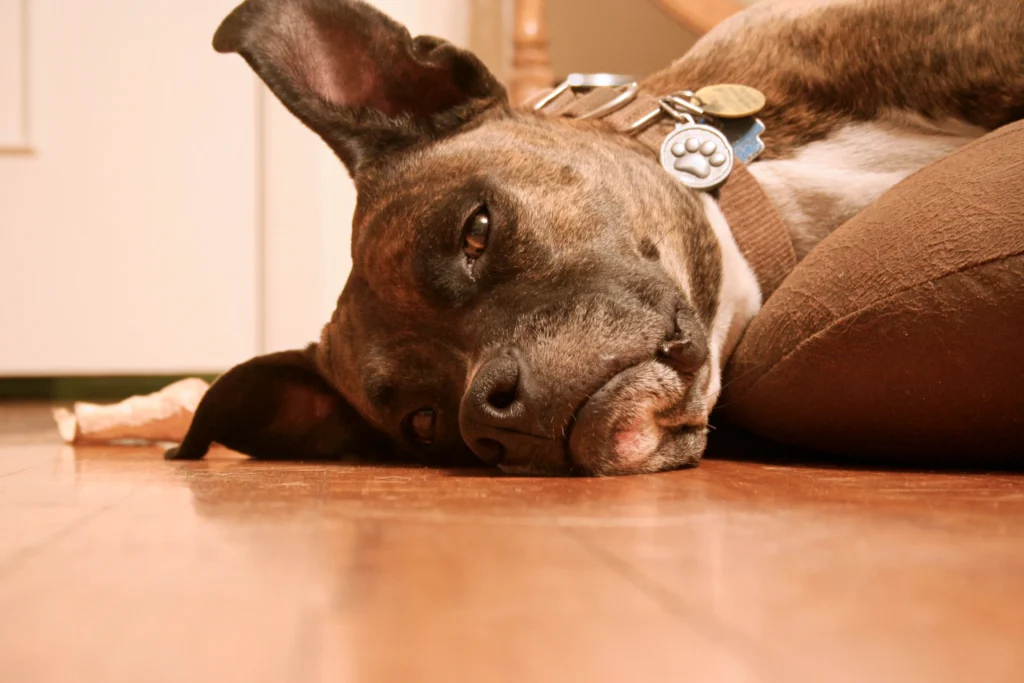
Emily, a proud Bullboxer Pit owner, shares her insights on the financial aspects of caring for her beloved pet:
“When I first brought Max, my Bullboxer Pit, home, I was prepared for the expenses. I spent around $1,200 to adopt him from a rescue organization. This included his vaccinations, neutering, and initial vet checkup. Annual vet visits and vaccinations cost me approximately $300-$400 per year.
In terms of food, I budget around $50 per month for high-quality dog food. Treats, toys, and grooming supplies add another $20-$30 per month. Regular grooming costs vary depending on your location, but I spend about $50 per grooming session.
Emergency vet visits can be a significant unexpected expense. Fortunately, I haven’t had many, but it’s essential to have a financial safety net for any unexpected health issues. Overall, I’d estimate my annual expenses for Max to be around $1,500-$2,000.”
2. Mike’s Perspective
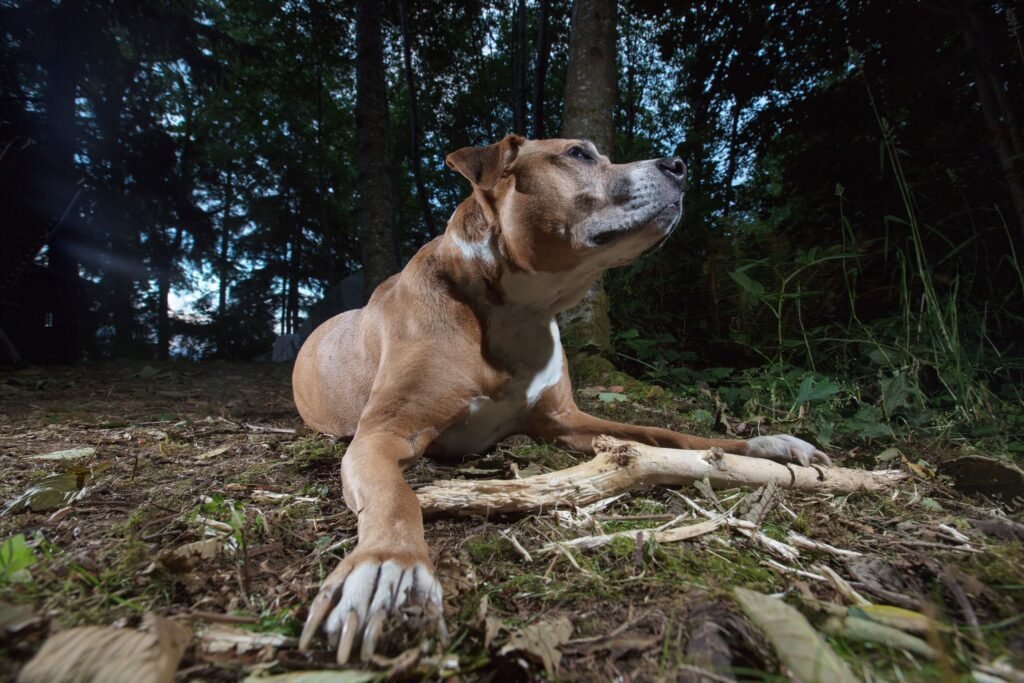
Mike, another Bullboxer Pit owner, discusses the importance of budgeting for his furry friend:
“When I decided to bring Bella into my family, I knew there would be expenses involved. Adoption fees can vary, but I paid about $800 to adopt Bella from a reputable rescue organization. This covered her spaying, initial vaccinations, and microchipping.
On a monthly basis, I allocate approximately $60 for high-quality dog food, treats, and basic grooming supplies. Bella’s grooming costs are around $60 per session, and I take her every 8-10 weeks.
Regular vet checkups and vaccinations add up to about $400-$500 per year. The biggest unexpected expense I encountered was when Bella needed surgery to remove a foreign object she swallowed, which cost me over $1,000.
In total, I’d estimate my yearly expenses for Bella to be around $2,000-$2,500, including both expected and unexpected costs. It’s essential to budget for your Bullboxer Pit’s well-being.”
Pros and Cons of Having a Bullboxer Pit
Every dog breed comes with its unique set of pros and cons. Here are personal testimonials from Bullboxer Pit owners who share their experiences:
1. Sarah’s Perspective on the Pros
Sarah highlights the positive aspects of having a Bullboxer Pit in her life:
“Owning a Bullboxer Pit like Rocky has been an incredibly rewarding experience. These dogs are loyal to a fault and form strong bonds with their families. Rocky is not only a loyal companion but also a protective one. I feel safe when he’s around.
Their playful nature is infectious. Rocky’s endless enthusiasm for playtime keeps me active and entertained. He’s excellent with kids and is gentle with my young niece.
Training Rocky was surprisingly easy due to his intelligence and eagerness to please. He quickly learned basic commands and even some fun tricks.
Overall, having a Bullboxer Pit has brought joy, companionship, and a sense of security into my life. I wouldn’t trade it for anything.”
2. John’s Perspective on the Cons
John shares some of the challenges he has encountered as a Bullboxer Pit owner:
“Owning a Bullboxer Pit like Luna has been an adventure, but it hasn’t been without its challenges. These dogs have a lot of energy, and if not properly exercised, they can become restless and display destructive behavior.
Luna’s protective instincts, while admirable, have sometimes made it challenging to introduce her to new people or animals. It requires careful socialization to ensure she’s comfortable in various situations.
Healthcare costs can be a significant financial commitment. Luna had a few health issues in her early years, and vet bills added up.
However, despite the challenges, the love and loyalty Luna brings into my life outweigh the cons. With the right training, socialization, and care, Bullboxer Pits can make fantastic pets.”
Final Thoughts
Personal stories and testimonials from Bullboxer Pit owners provide valuable insights into the joys and challenges of caring for this breed. While there are financial responsibilities associated with Bullboxer Pit ownership, the rewards in terms of loyalty, companionship, and playfulness are immeasurable. As with any dog breed, it’s essential to be prepared for both the expected and unexpected aspects of pet ownership. By understanding the costs, benefits, and potential challenges, you can make an informed decision about whether a Bullboxer Pit is the right fit for your family and lifestyle.
11. Breed-Specific Accessories and Care Products for Bullboxer Pits
When it comes to caring for your Bullboxer Pit, having the right accessories and care products can make a significant difference in their well-being and happiness. In this section, we will recommend specific accessories and care products tailored to the unique needs of Bullboxer Pits. Whether you’re looking for grooming tools, harnesses, toys, or other essentials, these recommendations can help you provide the best care for your beloved pet.
Grooming and Coat Care
1. Grooming Brush: Bullboxer Pits have short, dense coats that require regular brushing to remove loose hair and distribute natural oils. Consider a rubber curry brush or a grooming mitt for efficient shedding control.
2. Shedding Tool: To manage seasonal shedding, a deshedding tool like the Furminator can be highly effective. It reduces loose hair and helps keep your home cleaner.
3. Dog Shampoo: Opt for a gentle, hypoallergenic dog shampoo to keep your Bullboxer Pit’s coat clean and healthy. Look for formulas that won’t strip their natural oils.
4. Nail Clippers: Regular nail maintenance is essential. Invest in a good pair of dog nail clippers designed to prevent overcutting and keep your dog comfortable.
5. Ear Cleaning Solution: Bullboxer Pits can be prone to ear infections due to their floppy ears. Use a specialized dog ear cleaning solution to keep their ears clean and infection-free.
6. Toothbrush and Toothpaste: Dental health is crucial. Brush your Bullboxer Pit’s teeth regularly with a dog-friendly toothbrush and toothpaste to prevent dental issues.
Exercise and Play
1. Durable Toys: Bullboxer Pits are strong chewers and love interactive play. Invest in durable toys like Kong toys, which can withstand their powerful jaws.
2. Fetch Toys: Bullboxer Pits enjoy fetch games. A sturdy ball or frisbee can provide hours of entertainment.
3. Puzzle Toys: Mental stimulation is essential. Puzzle toys like the Outward Hound Hide-A-Squirrel can challenge their problem-solving skills.
4. Fetch Harness: If you enjoy playing fetch with your Bullboxer Pit, consider a specialized fetch harness. It allows for comfortable control and prevents strain during play.
5. Agility Equipment: For those interested in agility training, investing in agility equipment like tunnels, jumps, and weave poles can be both fun and mentally stimulating.
Safety and Training
1. Harness: Due to their strength, using a harness instead of a collar is recommended for walking and training your Bullboxer Pit. Look for a sturdy, no-pull harness that provides control without choking.
2. Leash: A strong, durable leash is essential. Consider a retractable leash for controlled freedom during walks.
3. Training Treats: High-quality, small training treats are excellent for reinforcing good behavior during training sessions.
4. Crate: Crate training can be beneficial, especially for housebreaking. Invest in a well-ventilated, comfortable crate that’s the right size for your Bullboxer Pit.
5. Dog ID Tags: Ensure your Bullboxer Pit always wears a secure ID tag with your contact information. Microchipping is also recommended for added safety.
6. Training Clicker: Some Bullboxer Pit owners find training clickers helpful for positive reinforcement training.
Health and Wellness
1. Flea and Tick Prevention: Depending on your location, flea and tick prevention products are essential. Consult your vet for recommendations.
2. Joint Supplements: Bullboxer Pits are prone to joint issues. Joint supplements with glucosamine and chondroitin can help support their joint health.
3. Elevated Feeder: To prevent bloat and promote healthy digestion, consider an elevated feeder for your Bullboxer Pit’s food and water.
4. Dog Bed: Provide your Bullboxer Pit with a comfortable, orthopedic dog bed to support their joints and ensure a good night’s sleep.
5. Pet Insurance: Consider pet insurance to help cover unexpected medical expenses. It’s especially valuable for breeds with potential health concerns.
Travel and Outdoor Gear
1. Car Seat Belt: Keep your Bullboxer Pit safe during car rides with a dog seat belt or harness attachment.
2. Travel Water Bottle: When on the go, a travel water bottle with a built-in bowl ensures your dog stays hydrated during outings.
3. Backpack: If you enjoy hiking or outdoor adventures, a dog backpack allows your Bullboxer Pit to carry their essentials and stay active.
4. Doggy Life Jacket: If you plan on swimming or boating with your Bullboxer Pit, a life jacket designed for dogs can provide safety and buoyancy.
Final Thoughts
Choosing the right accessories and care products for your Bullboxer Pit can enhance their overall quality of life and ensure their well-being. From grooming tools to exercise and play items, safety gear, and health supplements, these recommendations are tailored to the unique needs of this breed. Remember to consult with your veterinarian for personalized advice on the best products and care routines for your Bullboxer Pit’s specific health and lifestyle.
12. Frequently Asked Questions (FAQs) About Bullboxer Pits
As you explore the world of Bullboxer Pits, you’re likely to have questions about this unique breed. In this section, we’ve compiled a list of 10 common questions and provided detailed answers to help you better understand Bullboxer Pits. These FAQs cover various aspects of Bullboxer Pit ownership, behavior, health, and more.
1. What Is a Bullboxer Pit?
Answer: A Bullboxer Pit is a crossbreed dog resulting from the mating of a Boxer and an American Pit Bull Terrier. This breed combines the physical characteristics and personalities of its parent breeds, resulting in a strong, energetic, and loyal companion.
2. Are Bullboxer Pits Aggressive?
Answer: Bullboxer Pits, like any dog breed, can display aggression if not properly trained, socialized, or cared for. However, they are not inherently aggressive. With proper upbringing, socialization, and training, they can be friendly, loving pets.
3. Do Bullboxer Pits Get Along with Children and Other Pets?
Answer: Bullboxer Pits are known for their affectionate nature and can get along well with children when properly socialized from a young age. They can also coexist with other pets, although early socialization is essential to ensure compatibility.
4. What Is the Typical Lifespan of a Bullboxer Pit?
Answer: The average lifespan of a Bullboxer Pit is around 10 to 13 years. Providing proper care, nutrition, and regular veterinary check-ups can help maximize their lifespan.
5. How Do I Train a Bullboxer Pit?
Answer: Training a Bullboxer Pit requires consistency, positive reinforcement techniques, and early socialization. They are intelligent and eager to please, making them trainable. Consider enrolling in obedience classes for structured training.
6. What Are Common Health Issues in Bullboxer Pits?
Answer: Bullboxer Pits can be prone to health issues like hip dysplasia, allergies, and heart problems. It’s crucial to maintain regular vet check-ups to catch and address potential health concerns early.
7. Are Bullboxer Pits High-Maintenance in Terms of Grooming?
Answer: Bullboxer Pits have short, dense coats that are relatively low-maintenance. Regular brushing helps manage shedding, and occasional baths keep them clean. However, they may require more grooming if they inherit wrinkles from their Boxer parent.
8. Are Bullboxer Pits Good for First-Time Dog Owners?
Answer: Bullboxer Pits can be suitable for first-time dog owners with the right commitment to training, socialization, and care. However, they are strong and energetic, so novice owners should be prepared for their exercise needs.
9. Can Bullboxer Pits Live in Apartments?
Answer: While Bullboxer Pits are adaptable and can live in apartments, they require regular exercise and mental stimulation. Access to a fenced yard or nearby parks for play and walks is essential for their well-being.
10. Do Bullboxer Pits Make Good Guard Dogs?
Answer: Bullboxer Pits have protective instincts and can make excellent guard dogs. They are loyal and will alert you to any potential threats. However, proper training and socialization are necessary to ensure they don’t become overly aggressive or territorial.
Final Thoughts
Understanding the Bullboxer Pit breed and addressing common questions is essential for prospective owners. By following responsible breeding practices, providing proper training and care, and staying informed about their health and behavior, you can enjoy a rewarding and fulfilling relationship with your Bullboxer Pit. Remember that each dog is unique, so individual temperaments and needs may vary.
13. Conclusion
In this comprehensive guide, we’ve delved into the world of Bullboxer Pits, providing you with a wealth of information to help you understand and care for this unique breed. Let’s recap the key points we’ve covered, emphasize responsible ownership, and encourage adoption as we conclude our journey through the world of Bullboxer Pits.
Summarize Key Points
- Bullboxer Pit Overview: We introduced you to the Bullboxer Pit, a delightful crossbreed between a Boxer and an American Pit Bull Terrier. These dogs are known for their loyalty, affection, and playful nature.
- Breed Characteristics: We explored their physical attributes, temperament, exercise needs, grooming requirements, and health considerations in detail.
- Breed History and Origin: We delved into the history of the Bullboxer Pit, tracing their lineage and understanding how their origin influences their traits today.
- Understanding the Breed’s Traits: We provided insights into their physical characteristics, temperament, trainability, and suitability as family pets. We also discussed their compatibility with children and other pets.
- Health Considerations and Care: We highlighted common health issues, provided tips for promoting a longer and healthier life, explained their dietary needs, discussed exercise and grooming requirements, and emphasized the importance of regular vet check-ups.
- Choosing and Adopting a Bullboxer Pit: We encouraged responsible adoption, shared tips for research and preparation, explained the adoption process, and stressed the significance of ethical breeding practices.
- Popularity and Recognition: We discussed the breed’s current popularity, its recognition by kennel clubs and breed organizations, and explored notable breed varieties.
- Exercise and Activity Recommendations: We offered a detailed exercise plan, provided nutrition and feeding guidelines, and addressed specific dietary restrictions or allergies.
- Socialization and Training Tips: We provided breed-specific training tips and advice on socializing Bullboxer Pits with other dogs and people.
- Common Behavioral Traits: We discussed common behavioral traits associated with the breed and offered advice on managing and addressing these traits.
- Personal Stories and Testimonials: We shared real-life stories and testimonials from Bullboxer Pit owners, offering insights into the costs of ownership and the pros and cons of having this breed as a pet.
- Breed-Specific Accessories and Care Products: We recommended specific accessories and care products tailored to the Bullboxer Pit’s needs, from grooming tools to toys and safety gear.
- Frequently Asked Questions (FAQs): We addressed common questions about Bullboxer Pits, covering topics not covered in the main sections, including their aggression, suitability for first-time owners, and living conditions.
Responsible Ownership
Owning a Bullboxer Pit is a privilege that comes with significant responsibilities. These dogs are loving, loyal companions that thrive on positive interactions with their families. Responsible ownership involves:
- Proper Care: Meeting their physical and emotional needs, including regular exercise, nutritious food, grooming, and healthcare.
- Training and Socialization: Ensuring they receive proper training and socialization to become well-behaved and confident pets.
- Safety: Providing a safe environment, using appropriate accessories like harnesses and leashes, and protecting them from potential hazards.
- Ethical Breeding: Supporting responsible breeding practices and avoiding backyard breeders or puppy mills to promote the health and well-being of the breed.
Encourage Adoption
If you’re considering adding a Bullboxer Pit to your family, we strongly encourage adoption. Many Bullboxer Pits are waiting for loving homes in rescue organizations and shelters. By adopting, you not only provide a deserving dog with a second chance but also support ethical practices in the pet industry.
Resources for Adoption:
- Local Shelters: Visit your local animal shelters and rescue organizations to inquire about available Bullboxer Pits.
- Breed-Specific Rescues: Look for Bullboxer Pit breed-specific rescue groups that specialize in rehoming these dogs.
- Online Adoption Portals: Explore online adoption platforms that connect adopters with rescue organizations and shelters.
- Adoption Events: Attend adoption events or pet expos in your area, where you can meet rescue organizations and potential adoptable dogs.
Remember that adopting a pet is a long-term commitment, and it’s essential to choose a dog that aligns with your lifestyle and preferences. Be prepared to provide love, care, and a forever home for your Bullboxer Pit.
In closing, Bullboxer Pits are wonderful, affectionate companions that can bring joy and love to your life. With the right care, training, and responsible ownership, you can create a lasting bond with your Bullboxer Pit and enjoy the rewarding experience of having a loyal furry friend by your side.

